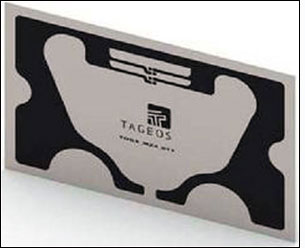Four years after French passive RFID hardware manufacturer Tageos was launched to develop a printable EPC Gen 2 passive ultrahigh-frequency (UHF) RFID label made without a plastic inlay—thereby reducing the cost and environmental impact of traditional tags—the company is now ready to market the results of those efforts. Rolls of the labels, designed to be low-cost and sustainable, are expected to become commercially available next month, either wet (backed with a pressure-sensitive adhesive) or dry (sans adhesive). The company intends to display these labels at RFID Journal LIVE! 2011, to be held on Apr. 12-14, in Orlando, Fla.
Tageos, headquartered in Montpellier, France, was founded in 2007 with $1.3 million of research and development money, to develop a new process for label manufacturing that the company predicts will reduce label prices by 10 to 30 percent—which, it believes, will encourage the adoption of RFID technology. RFID labels currently on the market are produced by taking a plain paper label and converting it by embedding an RFID inlay created on a separate plastic substrate. The RFID tag in a Tageos label, however, is created directly on the label itself, and thus has no plastic substrate and less adhesive, since there are no layers to glue together. The tag also has significantly thinner antennas, composed of a smaller amount of metal. According to Tageos, the tag’s read range will meet the needs of both logistics and item-level applications, though the company does not indicate the actual read ranges that users can expect.
The new labels come just as the UHF RFID tag market, according to IDTechEx, is expected to grow by as much as 120 percent this year, to $100 million. That growth, the firm indicates, will be the result of item-level tagging of apparel and other goods to meet retailers’ requirements. The apparel market, as well as jewelry and logistics, are the targeted end users for Tageos’ RFID labels.
The existing manufacturing processes for UHF tags are too expensive, says Lucien Repellin, Tageos’ business development VP, and also have a negative impact on the environment since they require a greater amount of material, compared with Tageos’ method. They require the etching, stamping, printing or electroplating of an antenna onto a substrate composed of polyethylene terephthalate (PET) plastic. A silicon RFID chip is glued onto the antenna, and an inlay may then be converted to a paper label. If, for example, a customer requires an adhesive printable paper label, such as one used for attachment to pallets, cases, retail apparel or jewelry, a label manufacturer traditionally had to first make or purchase an RFID inlay on a plastic substrate, and then insert that inlay into a paper label, which would also allow human-readable text to be printed on its surface.
The various steps in the process of producing an RFID label are usually accomplished by several companies, including those that manufacture the antennas, those that assemble a chip and an antenna onto a plastic substrate to form an inlay, and those that convert the inlay to a paper label. “What we wondered when the company was formed in 2007,” Repellin explains, “was how to remove the waste around the manufacturing of tags.” The solution, the company determined, was to eliminate the plastic substrate, which makes an RFID label bulkier than a non-RFID label, increases the cost, and impacts the environment since, the company says, plastic is a non-biodegradable material, adds weight to the transportation of products and is often made from petroleum.
Instead of manufacturing a plastic layer, therefore, the company can build a tag with a very thin aluminum antenna (which is just a fraction of a traditional RFID tag antenna’s thickness) manufactured directly onto a paper label. Instead of using etching, stamping, printing or electroplating to create an antenna, Tageos employs a different process that it declines to describe. Two to three years of the company’s development work were focused on this proprietary, patented process that enables the manufacturing of an antenna directly onto a label. An RFID chip is then added to the same paper label, and an adhesive layer is attached to the back of it. Because the RFID label manufacturing process is simpler, is accomplished entirely by Tageos and requires fewer raw materials (since there is no plastic substrate and less adhesive), the cost of manufacturing the label is significantly reduced, Repellin reports.
The labels, which utilize Impinj‘s Monza 4 chips, will be sold either directly to end users, or through systems integrators, including ODIN RFID, Seeonic and InSync Software. Future labels will also include chips from other suppliers, though the initial offering will use only the Impinj chips. “Every great technology inches along until the principal component prices drop significantly—computers, mobile phones and digital cameras all are great examples,” says Patrick J. Sweeney II, ODIN’s founder and CEO. “RFID will create billions of dollars in value and productivity when the tag prices are in the low pennies. Tageos has the technology to make the next big jump in RFID adoption come alive.”
Tageos also designs and manufactures antennas for use by RFID readers in special-needs cases, in which the existing RFID hardware on the market does not fit an end user’s requirements. “We have designed these antennas in order to be plugged on a fixed reader and a UHF near-field paddle to be plugged on to a PDA,” says Nicolas Jacquemin, Tageos’ VP of marketing and sales (see Cleor Strikes Gold With RFID and Implanet Tracks Implantables).
The new Tageos RFID label models being offered in April include the EOS-100, designed for jewelry, which can also be used with Tageos’ RFID reader antennas; the EOS-110, created for either jewelry or health-care products; the EOS-300, for identifying apparel; and the EOS-500, for identifying cases and pallets. Other EOS models are expected to become available in July, including the 200 and 410, for apparel; the 210, for museum artifacts; the 220, for small items; the 400, for airport luggage, cases and pallets; and the 600, for pallets and cases. Tageos declines to release the prices of these tags.
What’s more, Tageos has developed a paper label with an integrated sensor to be used by the food or health-care industries, for which the company has completed a prototype. “We should have first products in UHF ready by the end of 2012,” Jacquemin states. The company also plans to release HF RFID labels made without plastic substrates, and expects to release versions without sensors by the end of 2012, followed by versions with sensors in 2013.
In addition to its headquarters in France, the firm has also opened an office in California, managed by Repellin, in order to better access the American market.



